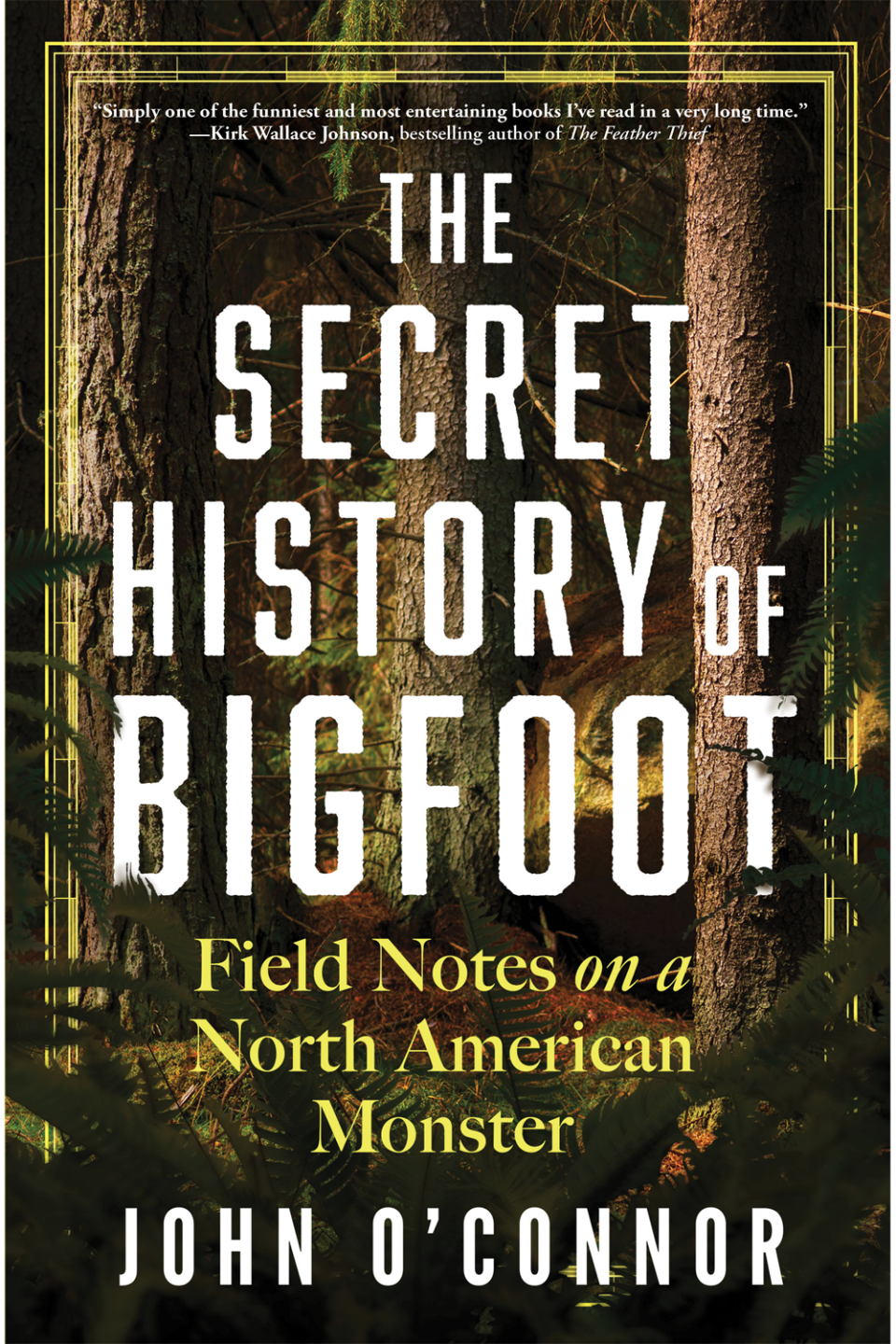Why So Many Americans Believe in Bigfoot
John O’Connor’s The Secret History of Bigfoot: Field Notes on a North American Monster is a work of mourning. Bigfoot, as O’Connor, a journalism professor, illustrates, is thriving—if by “Bigfoot” we’re talking about the legend of Sasquatch and the communities that have sprung up to seek out the hairy, towering primate said to lurk in the depths of America’s few remaining old-growth forests. It’s that Bigfoot, the symbol, who, O’Connor argues, flourishes and does so because of how much we’ve lost. This Bigfoot is a black armband commemorating everything from the environmental devastation wrought on the continent to the dearth of solitude and quiet available in contemporary life to … the decline of the white working class? Yes, even that.

Before I moved to rural Maine, I regarded Bigfoot as a strictly Pacific Northwest phenomenon. Then a sublimely daffy Facebook group called Unexplained Maine informed me that quite a few Mainers believe Bigfoot stalks the forests of northern Maine, including the Hundred-Mile Wilderness, the last and wildest stretch of the Appalachian Trail. (“There’s nothing but trees for miles and miles up there,” a neighbor told me after driving through the area. “And that’s when you realize that too many trees can drive you insane.”) O’Connor hits the Hundred-Mile Wilderness on his cross-country tour of Bigfoot hotspots, soaking up lore from a grizzled hiker about Bigfoots that are said to have devoured some early European explorers. This man even claimed that Geraldine Largay, a hiker who starved to death in the wilderness in 2013 after wandering off the trail and getting lost, had been kidnapped by Bigfoots as a food source. “Why would they starve her before eating her?” O’Connor asked, but his source just moved on to the next hair-raising yarn.
Maine isn’t the only state to boast Bigfoot sightings. In the course of researching this rambling but consistently diverting book, O’Connor traveled to woods in Kentucky, Massachusetts, California, Arkansas, and Texas, and he wraps everything up with his own fleeting glimpse of “a brownish blur and at least two reedy legs poking through long desert grass” in, of all places, New Mexico. It must be said that one of the things implicitly mourned by The Secret History of Bigfoot is the decline of glossy men’s adventure magazines like Outside, where a guy with O’Connor’s very evident descriptive chops and saucy attitude used to be able to rake in lucrative assignments chronicling his adventures in places like the Hundred-Mile Wilderness. Now he’s got to settle for using his outdoorsy getaways as a tax write-off—the Arkansas chapter in particular being a flagrant example. O’Connor rents a kayak to paddle around the Bayou De View, not because Bigfoots have been sighted there, but because the officially extinct ivory-billed woodpecker allegedly has. What exactly this has to do with Bigfoot is a bit foggy. A bit like his pal on the Appalachian Trail, O’Connor skates past the important distinction between a search for an animal that everyone agrees once existed and a search for an animal that almost certainly didn’t.
Bigfoot is most interesting as a figment of the popular imagination. The evidence for its reality, while plentiful, consists entirely of eyewitness statements and some photographs and film that are probably faked. (Unexplained Maine featured a classic example last year: two guys in a 4-wheel-drive vehicle with a cracked windshield who just happened to record their own casual conversation about Norm Macdonald while driving on a logging road and also just happened turn the camera in time to capture, without noticing it, a few frames of a tall, simian figure striding through the woods.) No physical specimen or its remains or even its scat have ever been obtained by a credible authority. Investigators for the more respectable groups, like the Bigfoot Field Research Organization, catalog and rate sightings and ostensibly collect hair and scat samples for DNA analysis, but no significant findings have been announced.
All of this provides O’Connor with the opportunity to expound on the many, many flaws in human perception and judgment, from the unreliability of eyewitness testimony to confirmation bias, suggestibility, and cherry-picking. How can thousands of eyewitness accounts of Bigfoot be wrong? Oh, so easily. The prime driver of such convictions, as with most beliefs, is desire. We believe what we want to believe, and then go looking for reasons to believe it. So what is it, O’Connor asks, that makes people (including him) want to believe in Bigfoot?
The most obvious and relatable answer is a longing for mystery, for an unknown wonder that will re-enchant our overly tamed world. “I can’t imagine living in a world where we’d figured everything out,” one Bigfoot believer—they call themselves Bigfooters—told O’Connor. This particular manifestation of that notion—as fantasy or as fear—has long held sway in the human imagination. Bigfooters often point to the many Native American stories about hairy humanoids living in New World forests, conveniently ignoring the fact that many, many folktales from around the world feature such legends, ranging from Enkidu in The Epic of Gilgamesh to European folklore about the “woodwose,” or wild man of the woods, to the Yeti of the Himalayas. Yet no one suggests that Bigfoot haunts the Black Forest of Germany, do they? Well, in fact, some do, but the omnipresence of such myths just tends to confirm the impression that, as with sun gods and shapeshifters, wild men and the tales we tell of them serve less as reports on reality than as windows into the human psyche.

So why, then, try to prove Bigfoot exists? Why set out to dispel the very mystery that makes you love him? Why launch hunting expeditions, submit evidence like scat or footprints, or attempt to establish through elaborate calculations and onsite research that the famous Patterson-Gimlin film—shot in California in 1967 and still the most famous photographic image of Bigfoot—is legit and not just footage of a guy in a gorilla suit? O’Connor tags along with a team doing just that, and as with many of his other adventures with Bigfooters, the outing supplies its own justification. He brings a six-pack. The guys sit by the campfire, savoring the woods and swapping stories about their Sasquatch encounters. “Belief for them,” O’Connor writes, “had as much to do with communal identity as with an animating sense of wonder. That was the heart of it, I thought: pals.” Then there’s the sense of adventure. “This was what Bigfooters love,” he explains: “the collateral kick of adrenaline that comes from doing what feels mischievous but is, in fact, good, wholesome fun, excitement at a higher rate of return than life normally offered.”
Even when off on a solitary quest, O’Connor seems motivated as much by the getaway as by the search. A good portion of The Secret History of Bigfoot consists of confessional passages about his restlessness, during the pandemic but even before it, as a stay-at-home dad in Cambridge. There’s a long, interesting, but seemingly irrelevant section on the American monk Thomas Merton and the monk’s desire to live a life of seclusion. O’Connor also lovingly recalls an incident during his Boy Scout camping days when troop masters pranked the boys by making scary noises in the woods. He loved “how the known world could vanish in an instant, our sense of possibility dramatically enlarged, our boring, lily-white, cozy middle-class lives momentarily upturned by mystery and menace.” Such is the “boring” life the writer himself has fled to camp out in the wilderness alone. “If nothing else,” a biologist told him of the Bigfooters’ cause, “it’s an excuse to spend time in the woods.”
But the Bigfooters, much as he vibes with many of them, also trouble O’Connor. They are almost all “old white guys, young white guys, middle-aged white guys.” Former cops and military men strike him as overrepresented in the cohort, and he knows that Bigfoot belongs to a constellation of vaguely paranormal beliefs that may seem harmless but can lead the faithful down some dark paths. He finds an unsettling convergence between Bigfooters and Trumpers, an overlap including “extreme reactionary views, a tendency toward the sensationalistic, a fetishization of traditional masculinity, a hard-bitten mistrust of urban elites generally and the federal government and its scientific minions specifically, coupled with an inverse, reflexive flag waving and suspicion of ‘protestors’ and ‘kneelers.’ ” For someone who by all accounts hates nature, animals, and roughing it, Trump crops up in The Secret History of Bigfoot with a surprising frequency.
What Bigfoot expresses for some believers, is, O’Connor surmises, “titanic disquiet at the unwinding of the white working-class world and fulfilling a desire for magical reassurance that the old regime, despite appearances, would endure.” This strikes me as a stretch too far. Aren’t those just the Bigfoot believers who like to camp out, who not only love “their gear and their big trucks and their big guns and all of their infrared things” but who own such things in the first place? I’ve known a few believers who were neither white nor working class. They weren’t about to spend their money on tents or traveling to Bigfoot conventions, but they were still convinced that Bigfoot is real. I may not share that faith, but I think the longing behind it is universal, and something I share. It’s the hope that our predecessors have not extracted and cataloged everything the world has to offer, that somewhere out there, there are still some secrets left.

